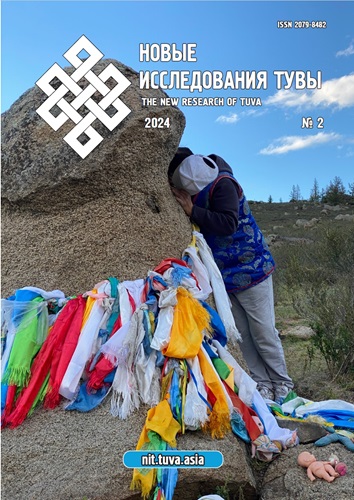Folk ornament in Soviet documentary films of Kazakhstan and Kyrgyzstan: stages of fixation and comprehension historical memory
DOI:
https://doi.org/10.25178/nit.2024.2.17Keywords:
Kazakhstan; Kyrgyzstan; USSR; Kazakhs; Kyrgyz people; nomads; ornamentation; documentary film; pattern; historical memory; memory politics; memory studies; visual narrative; applied artsAbstract
The article is dedicated to the representations of folk ornamentation and traditional crafts of Kazakhs and Kyrgyz people in documentary films made during the Soviet era in Kazakhstan and Kyrgyzstan. In conjunction with ornament, such popular sources often explore associated, symbolically charged forms of visual culture of these peoples: petroglyphs, tamgas, ancient scripts, etc. Considering cinema as one of the types of historical discourse, the author is looking for evidence of memory politics in it. The article analyzes fifteen documentary films created during the period of 1936–1984, from reports in newsreels to full-length films. The studied films are archived in the Central State Archive of Film, Photo, and Sound Records of the Republic of Kazakhstan and the Central State Archive of Film, Photo, and Sound Records of the Kyrgyz Republic.
Examining and interpreting the film materials allows for identifying certain features of cultural politics related to questions of historical memory and ethno-cultural identification. The author examined the development of documentary cinematography dedicated to ornamentation in the context of the adaptation and modernization of traditional crafts in Central Asia, the evolution of academic representations of traditional signs and symbols of Kazakhs and Kyrgyz people, and the activities of the Soviet intelligentsia. The analysis demonstrates how narratives, images, and artistic features displayed on screen have changed: if before the 1970s there was a prevailing rigid ideological line, including the appropriation of ornament, and its connection with historical memory was either ignored or interpreted strictly in a class-based and socialist realist reading (with authors being documentarians and reporters from Moscow and Leningrad), then in subsequent films about the ornament and folk art of Kazakhs and Kyrgyz people, themes of nomadism, unity of nature and man, ancestral heritage, characteristic of ethno-metaphysics and essential for the creation of national identity, began to appear more frequently (with authors being directors, screenwriters, and artists from Kazakhstan and Kyrgyzstan). This was particularly evident in those documentary films that employed poetic cinema techniques.
References
Anisimov, V. E., Borisova, A. S. and Kalinnikova, E. D. (2022) Images of Traditional and Modern Tuva in Ethnographic Cinema (based on the film of S. Rodnina and A. Menshov “Tyva Planet”). New Research of Tuva, no. 1, pp. 183–197. (In Russ.). DOI: https://doi.org/10.25178/nit.2022.1.12
Antipina, K. I. (1962) Features of the material culture and applied art of the southern Kyrgyz. Based on materials collected in the southern part of the Osh region of the Kyrgyz SSR. Frunze, Izdatel'stvo AN Kirgizskoi SSR. 288 p. (In Russ.).
Bragina, M. A. and Levina, V. N. (2023) The image of Tuva’s space in Runet. New Research of Tuva, no. 4, pp. 185–199. (In Russ.). DOI: https://doi.org/10.25178/nit.2023.4.13
Volkov, E. V. And Ponomareva, E. V. (2012) Feature films as a historical source for the study of cultural memory. Vestnik IuUrGU. Seriia «Sotsial'no-gumanitarnye nauki», no. 10 (269), pp. 22–25. (In Russ.).
Golovnev, I. A. (2021) Images of Tuva in Soviet Cinema of the 1930s (The Case of Boris Nebylitsky’s Creativity). New Research of Tuva, no. 4, pp. 119–130. (In Russ.). DOI: https://doi.org/10.25178/nit.2021.4.9
Dashieva, L. D. (2021) Anthropology of sound in the traditional culture of the mongolian peoples. Tomsk Journal of Linguistics and Anthropology, no. 3 (33), pp. 118–126. (In Russ.). DOI: https://doi.org/10.23951/2307-6119-2021-3-118-126
Deleuze, G. (2019) Movie: transl. from Fr. Moscow, Ad Marginem Press. 560 p. (In Russ.).
Krupko, I. V. (2023) Subjectivity of the kazakh nomadic culture in the 1960s poetry of Olzhas Suleimenov. Ural Historical Journal, no. 1 (78), pp. 123–132. (In Russ.). DOI: https://doi.org/10.30759/1728-9718-2023-1(78)-123-132
Lotman, Yu. M. (1973) Semiotics of cinema and problems of cinema aesthetics. Tallinn, Eesti raamat. 135 p. (In Russ.).
Mal'chik, A. Yu. (2005) The history of Kyrgyz folk applied art: the evolution of Kyrgyz ornament from ancient times to the twentieth century. Bishkek, Kyrgyzskii gosudarstvennyi universitet im. I. Arabaeva. 122 p. (In Russ.).
Manichkin, N. A. (2023) Interdependent formation: poetic interpretation of symbols and images of historical memory in Kazakhstan. Elektronnyi nauchnyi zhurnal «edu.e-history.kz», vol. 10, no. 2, pp. 334–346. (In Russ.). DOI: https://doi.org/10.51943/2710-3994_2023_34_2_334-346
Ryndin, M. V. (2016) Samples of Kyrgyz ornament. In: Kyrgyz national pattern / ed. by I. A. Orbeli. Bishkek, Tsentral'no-Aziatskaia set' po kul'ture i iskusstvu. 120 p. Pp. 8–20. (In Russ.).
Sokolova, T. M. (1972) The ornament is the handwriting of the epoch. Leningrad, Avrora. 148 p. (In Russ.).
Epigraphy of Kyrgyzstan (1963) / comp. by Ch. Dzhumagulov, ed. by A. I. Batmanov. Frunze, Izdatel'stvo AN Kirgizskoi SSR. Issue 1. 70 p. (In Russ.).
Assmann, A. (2011) Cultural Memory and Western Civilization: Functions, Media, Archives. Cambridge, Cambridge University Press. 424 p.
Assmann, J. (2012) Cultural memory and Early Civilization: Writing, Remembrance and Political Imagination. Cambridge, Cambridge University Press. 332 p. DOI: https://doi.org/10.1017/CBO9780511996306
Bodnar, J. (1992) Remaking America: Public Memory, Commemoration, and Patriotism in the Twentieth century. Princeton, Princeton University Press. 312 p.
Gräslund, A.-S. (2018) Ornamentation. In: Handbook of Pre-Modern Nordic Memory Studies. Interdisciplinary Approaches. Eds. by J. Glauser, P. Hermann and S. A. Mitchell. Berlin/Boston, Walter de Gruyter GmbH. Vol. 1–2. 1163 p. Pp. 643–670.
Halbwachs, M. (1992) On collective memory. Chicago, The University of Chicago Press. 254 p.
Kolibu, R. M. P., Sachari, A., Setiawan, P. and Rohendi, T. R. (2021) Redefinition of Waruga Ornaments in Minahasa, Indonesia: Actualisation of Pattern and Meaning Transformation from Makam to Mukim. Palarch’s Journal of Archaeology of Egypt / Egyptology, no. 18 (17), pp. 259–276.
Nancy, J.-L. (2007) Listening. New York, Fordham University Press. 108 p.
O’Callaghan, C. (2017) Beyond Vision: Philosophical Essays. Oxford, Oxford University Press. 240 p. DOI: https://doi.org/10.1093/acprof:oso/9780198782964.001.0001
Parr, A. (2010) The Deleuze Dictionary. Revised Edition. Edinburgh, University Press. 326 p. DOI: https://doi.org/10.1515/9780748643271
Warburg, A. (2010) Atlas Mnemosyne. Madrid, Ediciones Akal Sa. 188 p.
Published
How to Cite
For citation:
Manichkin N. A. Folk ornament in Soviet documentary films of Kazakhstan and Kyrgyzstan: stages of fixation and comprehension historical memory. New Research of Tuva, 2024, no. 2, pp. 285-299. (In Russ.). DOI: https://doi.org/10.25178/nit.2024.2.17
Issue
Section

This work is licensed under a Creative Commons Attribution-NonCommercial 4.0 International License.

Author(s) license holder(s) grant rights for their work to the journal (grantee of a license) under the simple non-exclusive open license in accordance with Art. 1286.1 «Open license for a research work, work of literature or fine arts», Civil Code of the Russian Federation.
New Research of Tuva publishes articles under the Creative Commons Attribution-NonCommercial license (CC BY-NC).
Since it is an open license, author(s) reserve the right to upload the article to their institutional repository, submit it to another journal (if it allows republications), or republish it on their own website (in full, or in part).
However, several conditions apply here:
a) The republished version must always contain the name(s) and affiliation(s) of the author(s), the original title and the hyperlink to the original version on the New Research of Tuva website;
b) It must be in open access, free of charge, and no category of readers must be in any way whatsoever advantaged over general readership.
c) should the contribution be submitted elsewhere by its author(s) without substantial modification (30% or more of original text unchanged), the body of the article should contain a disclaimer that the original version was published in New Research of Tuva (with a link to the respective page)
The CC-BY-NC is a non-revocable license which applies worldwide and lasts for the duration of the work’s copyright.









